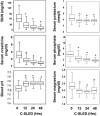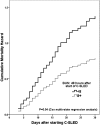Sustained low efficiency dialysis in the continuous mode (C-SLED): dialysis efficacy, clinical outcomes, and survival predictors in critically ill cancer patients
- PMID: 19628685
- PMCID: PMC2723965
- DOI: 10.2215/CJN.02130309
Sustained low efficiency dialysis in the continuous mode (C-SLED): dialysis efficacy, clinical outcomes, and survival predictors in critically ill cancer patients
Abstract
Background and objectives: Oliguric, hypotensive patients who require large amounts of fluids may benefit from sustained low-efficiency dialysis performed continuously (C-SLED). C-SLED through higher clearance may improve survival, or through greater nutritional loss may worsen survival. No studies have assessed survival on C-SLED. The objective was to examine patient outcomes and survival predictors on C-SLED.
Design, setting, participants, & measurements: The data of 199 consecutive cancer patients treated with C-SLED were analyzed. The median duration of C-SLED was 50 h. With 48 h of C-SLED, the blood urea nitrogen (BUN) and serum creatinine levels had decreased by 80% and 73%, respectively. The mean arterial pressure (MAP) was maintained despite higher ultrafiltration and reduced vasopressor use. The 30-d mortality rate was 65%. Despite excellent dialysis, the sequential organ failure assessment (SOFA) score remained predictive of mortality. In the univariate model, higher SOFA scores and lower values for MAP, blood pH, and serum albumin and creatinine levels were associated with higher mortality. Administration of total parenteral nutrition (TPN) was, however, associated with lower mortality.
Results: In the multivariate model, the higher SOFA score and lower blood pH, MAP and C-SLED duration were associated with higher mortality. In a subset analysis of 129 patients who received C-SLED for at least 48 h, those with higher BUN levels, which were associated with higher TPN infusion, had a lower mortality risk.
Conclusion: This first detailed report on C-SLED indicates that C-SLED can be effective and suggests a link between nutrition and survival.
Figures





Similar articles
-
Safety of regional citrate anticoagulation for continuous sustained low efficiency dialysis (C-SLED) in critically ill patients.Ren Fail. 2005;27(5):541-5. doi: 10.1080/08860220500198748. Ren Fail. 2005. PMID: 16152991
-
Comparison of outcomes of different modalities of renal replacement therapy in patients of acute kidney injury: a single centre prospective observational study.Rom J Intern Med. 2023 Dec 28;62(2):138-149. doi: 10.2478/rjim-2023-0033. Print 2024 Jun 1. Rom J Intern Med. 2023. PMID: 38153884
-
Outcomes of sustained low efficiency dialysis versus continuous renal replacement therapy in critically ill adults with acute kidney injury: a cohort study.BMC Nephrol. 2015 Aug 4;16:127. doi: 10.1186/s12882-015-0123-4. BMC Nephrol. 2015. PMID: 26238520 Free PMC article.
-
Local experience with the use of sustained low efficiency dialysis for acute renal failure.Intensive Crit Care Nurs. 2009 Feb;25(1):45-9. doi: 10.1016/j.iccn.2008.09.001. Epub 2008 Oct 16. Intensive Crit Care Nurs. 2009. PMID: 18929488 Review.
-
Daily haemodialysis in acute renal failure. Old wine in a new bottle?Minerva Urol Nefrol. 2004 Sep;56(3):265-77. Minerva Urol Nefrol. 2004. PMID: 15467505 Review.
Cited by
-
Acute kidney injury in critically ill cancer patients: an update.Crit Care. 2016 Aug 2;20(1):209. doi: 10.1186/s13054-016-1382-6. Crit Care. 2016. PMID: 27480256 Free PMC article. Review.
-
Incidence rate, clinical correlates, and outcomes of AKI in patients admitted to a comprehensive cancer center.Clin J Am Soc Nephrol. 2013 Mar;8(3):347-54. doi: 10.2215/CJN.03530412. Epub 2012 Dec 14. Clin J Am Soc Nephrol. 2013. PMID: 23243268 Free PMC article.
-
Evaluation of Intermittent Hemodialysis in Critically Ill Cancer Patients with Acute Kidney Injury Using Single-Pass Batch Equipment.PLoS One. 2016 Mar 3;11(3):e0149706. doi: 10.1371/journal.pone.0149706. eCollection 2016. PLoS One. 2016. PMID: 26938932 Free PMC article.
-
Acute kidney injury in cancer patients: A nationwide survey in China.Sci Rep. 2019 Mar 5;9(1):3540. doi: 10.1038/s41598-019-39735-9. Sci Rep. 2019. PMID: 30837515 Free PMC article.
-
Renal Replacement Therapy in Patients With Stage IV Cancer Admitted to the Intensive Care Unit With Acute Kidney Injury at a Comprehensive Cancer Center Was Not Associated With Survival.Am J Hosp Palliat Care. 2020 Sep;37(9):707-715. doi: 10.1177/1049909120902115. Epub 2020 Jan 27. Am J Hosp Palliat Care. 2020. PMID: 31986903 Free PMC article.
References
-
- Hoste EA, Schurgers M: Epidemiology of acute kidney injury: How big is the problem? Crit Care Med 36: S146–S151, 2008 - PubMed
-
- Soares M, Salluh JI, Carvalho MS, Darmon M, Rocco JR, Spector N: Prognosis of critically ill patients with cancer and acute renal dysfunction. J Clin Oncol 24: 4003–4010, 2006 - PubMed
-
- Schlaeper C, Amerling R, Manns M, Levin NW: High clearance continuous renal replacement therapy with a modified dialysis machine. Kidney Int Suppl 72: S20–S23, 1999 - PubMed
-
- Marshall MR, Golper TA, Shaver MJ, Alam MG, Chatoth DK: Sustained low-efficiency dialysis for critically ill patients requiring renal replacement therapy. Kidney Int 60: 777–785, 2001 - PubMed
-
- Tolwani AJ, Wheeler TS, Wille KM: Sustained low-efficiency dialysis. Contrib Nephrol 156: 320–324, 2007 - PubMed
MeSH terms
Substances
LinkOut - more resources
Full Text Sources
Medical
Research Materials

